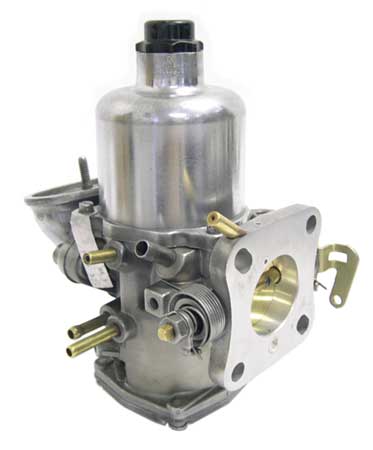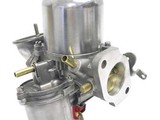SU CARBURETORS - How They Work

Basic Knowledge
Even though the SU carburetor (carb) is a very basic yet precise instrument, some fundamental understanding on just how it works is needed to be able to deal with common problems and tuning. Following is as basic a description of what's going on that I can manage! First you need to be comfortable with the main aim of any carb - to supply the engine with a finely atomized fuel/air mixture in the right strength for all operating conditions. This means from idle to flat out and everything in-between. All carbs achieve this using the same method - a venturi or choke (restriction) is used to speed up the velocity of the in-coming air to create a reduction in pressure. This is used to draw fuel from the float chamber via a suitably sized jet hole into the air stream, and hence into the engine.
The perfect carburetor will supply the engine with optimum mixture for both maximum power throughout the full throttle-angle range (variable restriction - as in butterfly and spindle) and minimum consumption under all part-throttle conditions. Easy, eh?
All Choked Up
As air passes through a choke of a fixed size its velocity and depression over the fuel jet hole varies with engine demand, generally controlled by the throttle (i.e. how far open it is). This varying depression needs some form of control/compensation to produce the correct fuel flow. It also compromises the choke size choice. Too small will cause a restriction to top end performance, too large will cause poor fuel metering and low speed running. One solution where a single fuel outlet point (jet hole) is used is the variable choke. As the name suggests, this provides a means where the choke size will become larger as demand increases, smaller when it diminishes. This will ensure a constant air velocity and depression across the jet hole. And that's exactly the method used in the SU where the closely fitting piston/suction disc assembly in the suction chamber (commonly known as the 'dashpot') varies the choke size as it rises and falls. The rise and fall is effected by a series of holes. There are usually two in the under side or side of the piston facing the butterfly, and lead up into the suction chamber. These sense any depression existing between the jet hole and butterfly, passing this into the suction chamber. The under side of the piston/suction disc is vented to atmosphere by another pair of holes. Usually on the air cleaner mounting flange.
Fueling About
To go with our variable choke size we need to control the fuel flow rate accordingly. Simply achieved by a tapered needle fixed to the piston/suction disc moving in and out of the fixed jet hole size. Accurate dimension of the tapered needle gives the correct fueling for each application. Enrichment for cold starting is again simply achieved by lowering the jet tube, a linked lever that also opens the butterfly slightly.
Sum of the Parts
It works like this. Opening the butterfly allows manifold depression to be passed to carb body and suction chamber, causing the piston to rise. This allows a fuel/air mixture to pass underneath it to relieve the depression. The piston stops rising once the depression has reached a value sufficient to balance the combined weight of piston and piston spring. The piston height achieved is therefore governed by the mass of fuel/air flowing under it. The same depression is obtained whatever the demand, and is arranged to be sufficient to give optimum atomization, yet small enough for adequate filling at high engine speeds.
Close Control
The piston also has a hollow tube up the middle of it to hold an oil reservoir. A one-way valve runs in this, fitted to the end of the damper rod. This restricts the rate at which the piston rises, but allows it to fall freely when the butterfly is shut. Its purpose is to cause mixture enrichment needed for decent 'pick-up' when accelerating. This occurs because the damper's slowing of piston lift speed increases the depression over the jet hole. The result is extra fuel being drawn into the air stream. The 'accelerator pump' of the SU. Damper oil temperature fine-tunes control of this. Its high cold viscosity slows the piston further causing greater enrichment when cold, easing as it gets warmer. How simple can you get?
Carb Questions? Call our specialists at 1-800-946-2642 or send us an email.
Browse Carburetors








